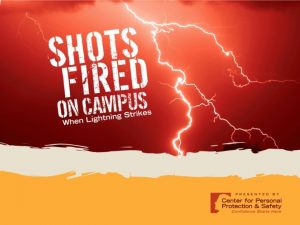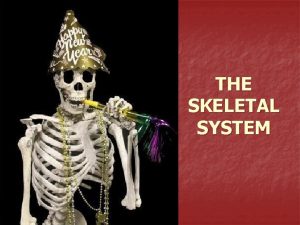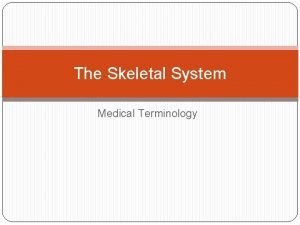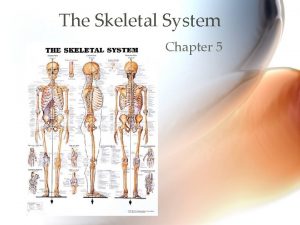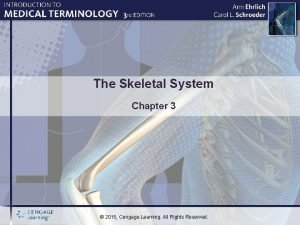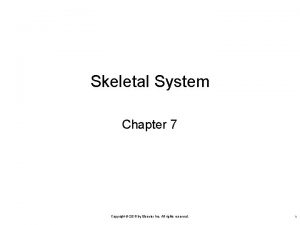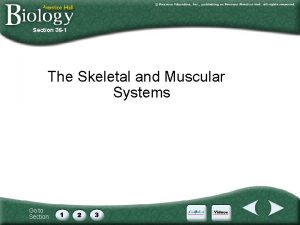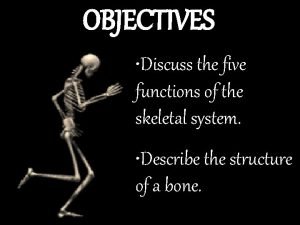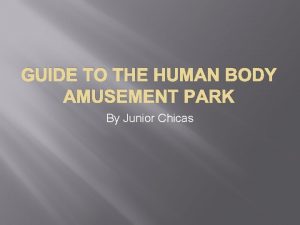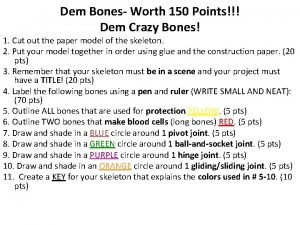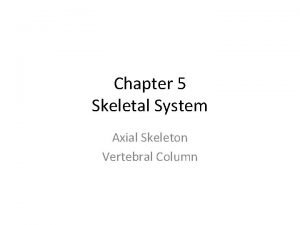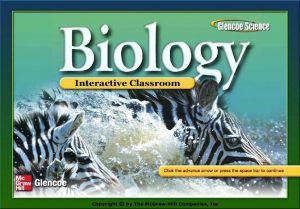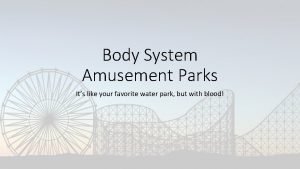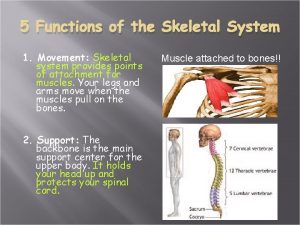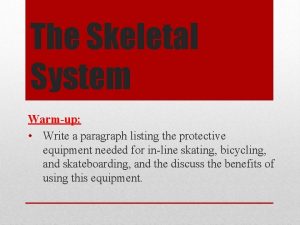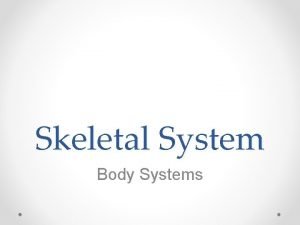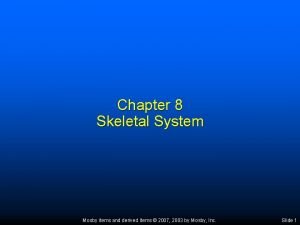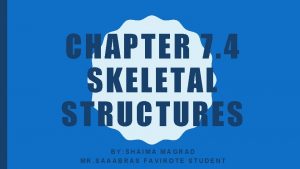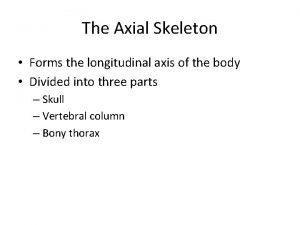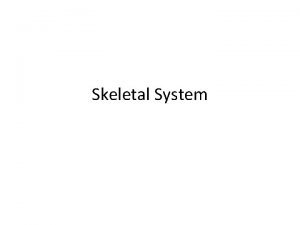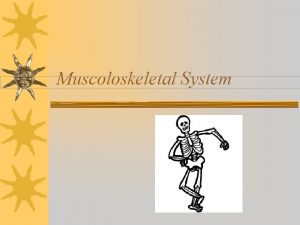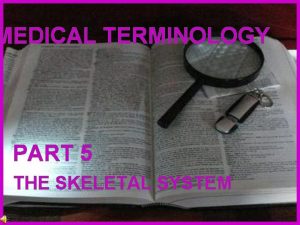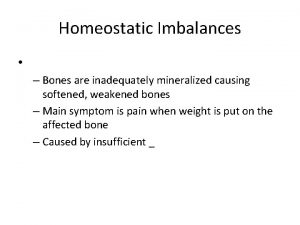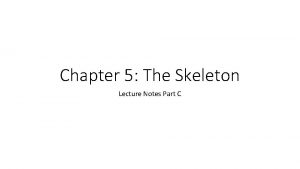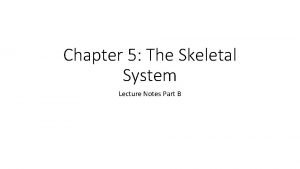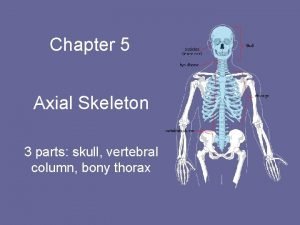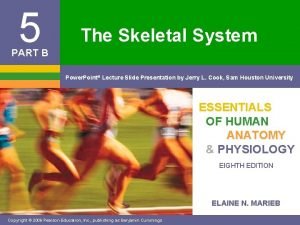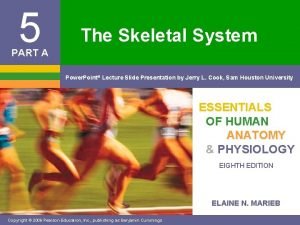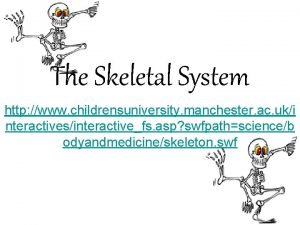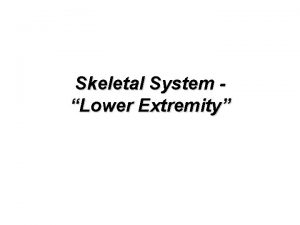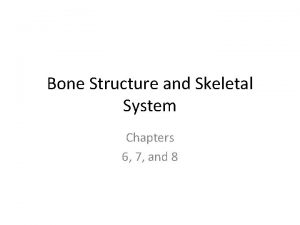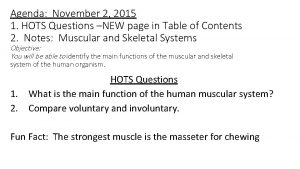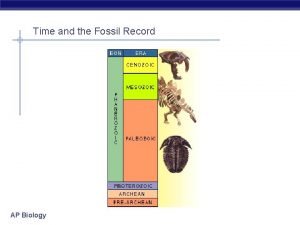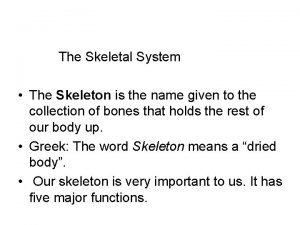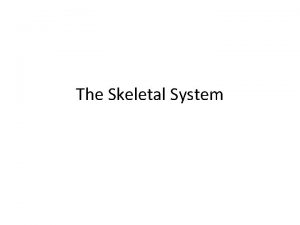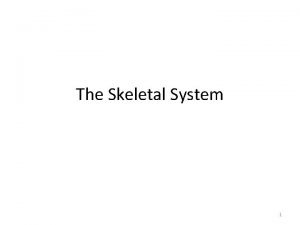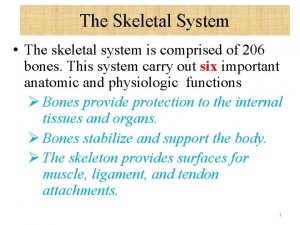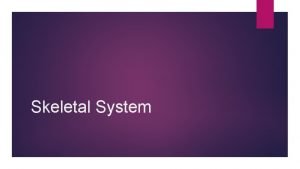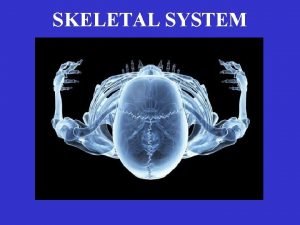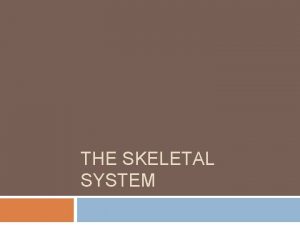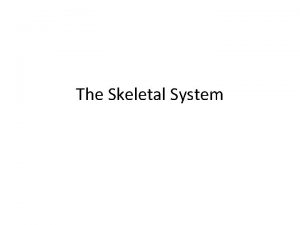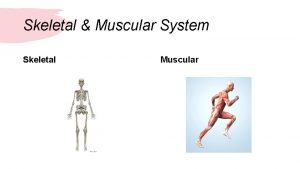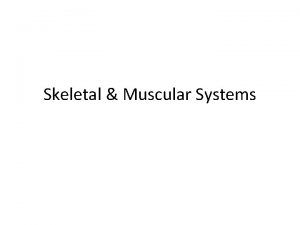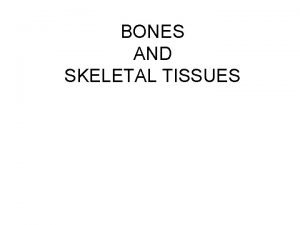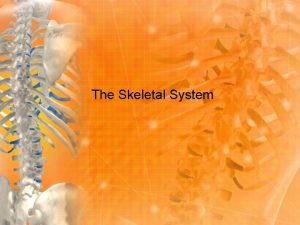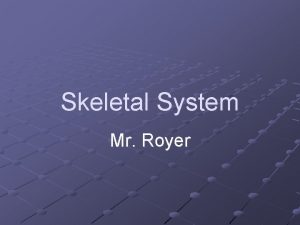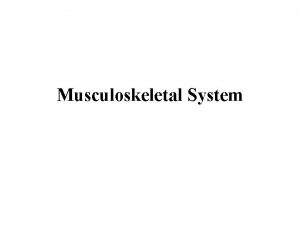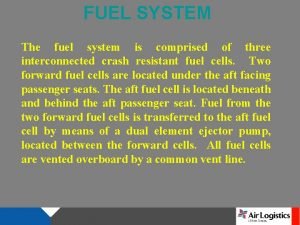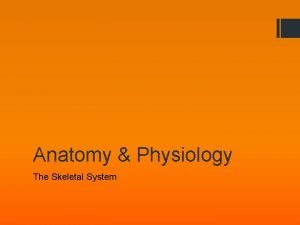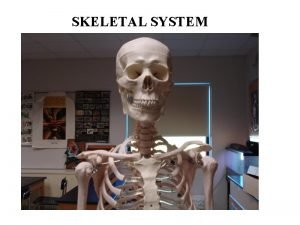The Skeletal System The skeletal system is comprised


![Combining Forms Crani/o = cranium (skull bones), [craniotomy] Stern/o = sternum (breastbone), [sternocostal] Cost/o Combining Forms Crani/o = cranium (skull bones), [craniotomy] Stern/o = sternum (breastbone), [sternocostal] Cost/o](https://slidetodoc.com/presentation_image_h2/18aa31b8605045b541d3f2a21543c925/image-3.jpg)














































- Slides: 49

The Skeletal System • The skeletal system is comprised of 206 bones. This system carry out six important anatomic and physiologic functions Ø Bones provide protection to the internal tissues and organs. Ø Bones stabilize and support the body. Ø The skeleton provides surfaces for muscle, ligament, and tendon attachments. 1

General Ø Bones (through joints) move through lever action when skeletal muscles contract. Ø Bones store minerals, especially calcium and phosphorus. Ø Bones also make blood cells in the marrow, a process called haemopoesis or hematopoiesis 2
![Combining Forms Cranio cranium skull bones craniotomy Sterno sternum breastbone sternocostal Costo Combining Forms Crani/o = cranium (skull bones), [craniotomy] Stern/o = sternum (breastbone), [sternocostal] Cost/o](https://slidetodoc.com/presentation_image_h2/18aa31b8605045b541d3f2a21543c925/image-3.jpg)
Combining Forms Crani/o = cranium (skull bones), [craniotomy] Stern/o = sternum (breastbone), [sternocostal] Cost/o = ribs, costal (related to ribs) , costoclavicular, [subcostal meaning below ribs] , Spondyl/o = vertebrae (backbone), spondylolisthesis, spondylitis Vertebr/o = [vertebral] 3

• Cephal/o is the combining form for the direction “close to the head” • Cephalodynia is pain in the head, or headache. • The prefix en- refers to “in”. When combined with cephal/o, we get encephal/o which translates into “in the head” e. g. encephalography. This is the another term for brain. 4

Combining Forms Humer/o = humerus (upper arm or arm) Carp/o = carpus (wrist), carpometacarpal Metacarp/o = metacarpus (hand), metacarpophalangeal Phalang/o = finger/toe Pelv/i = pelvis (hip bones), NOTE the exception to the combining vowel. [pelvimetry meaning process of measuring the hips] 5

Combining Forms (cont. ) Metatars/o = metatarsals Ankyl/o = stiff, bent, crooked Arthr/o = joint cervic/o = neck Lamin/o = lamina (part of the vertebral arch) Myel/o = spinal cord, bone marrow Orth/o = straight Oste/o = bone 6

Combining Forms (cont. ) Femor/o = femur (thigh bone), femoral Patell/o = patella (kneecap), [patellopexy (fixation)] Tibi/o = tibia (shin) Fibul/o = fibula (smaller lower leg bone) Calcane/o = calcaneus (heel bone) Tars/o = tarsal 7

Combining Forms (cont. ) • The combining form oste/o refers to a bone. Therefore, osteodynia refers to painful bones. Osteocytes are the main cells that make up bones 8

Shapes of Bones • Long (cylindrical) bones: are the main bones of the limbs, except the patella, and those of wrists and ankles, fingers and toes. • Short bones: are the bones of the wrists, ankles • Flat bones: include the sternum, scapulae, and cranium • Irregular bones: include the vertebrae and hip bones. 9

Axial skeleton • • The axial skeleton forms the body’s vertical axis. It includes bones of the skull, vertebral column, and rib cage. There are 74 bones in the head and torso; head’s bones also include 6 bones of the middle ear, for a total of 80 bones. Ø The skull; contains 28 irregular bones • Cranium (8 bones) • Face (14 bones) • Ear ossicles (6 bones) Ø Facial bones • Maxillary bones (upper jaw, nose, orbits, roof of the mouth, and maxillary sinuses) • Zygomatic or malar bones • Two nasal bones (nasal bridge) • The mandible; the only movable bone in the skull Ø The spinal column (flexible part 24 vertebrae + sacrum + coccyx ) • Cervical (neck) (7 vertebrae) cervic/o • Thoracic (chest) (12 vertebrae) thorac/o • Lumber (lower back) (5 vertebrae) lumb/o • Sacrum, single bone from fusion of 5 vertebrae sacr/o • Coccyx (tail bone), single bone from fusion of 4 or 5 vertebrae Ø Sternum, attached to the clavicles and the innermost part of the first seven pairs of ribs. Ø Ribs, the first 7 pairs of ribs are called true ribs, the remaining 5 pairs are called false ribs 10

Axial skeleton • The axial skeleton forms the body’s vertical axis. It includes bones of the skull, vertebral column, and rib cage. • There are 74 bones in the head and torso; head bones also include 6 bones of the middle ear, for a total of 80 bones. ØThe skull; contains 28 irregular bones § Cranium (8 bones) § Face (14 bones) § Ear ossicles (6 bones) 11

Axial skeleton ØFacial bones § Maxillary bones (upper jaw, nose, orbits, roof of the mouth) § Zygomatic or malar bones § Two nasal bones (nasal bridge) § The mandible; the only movable bone in the skull 12

Axial skeleton ØThe spinal column (flexible part 24 vertebrae + sacrum + coccyx) § Cervical (neck) (7 vertebrae) cervic/o § Thoracic (chest) (12 vertebrae) thorac/o § Lumber (lower back) (5 vertebrae) lumb/o § Sacrum, single bone from fusion of 5 vertebrae sacr/o 13

14

Axial skeleton § Coccyx (tail bone), single bone from fusion of 3 or 5 vertebrae ØSternum, attached to the clavicles and the anterior part of the first seven pairs of ribs. ØRibs, the first 7 pairs of ribs are called true ribs, the remaining 5 pairs are called false ribs 15

Appendicular skeleton The upper extremities Ø Clavicles (collarbones). – Sternoclavicular joint – Articulation with the scapulae (acromioclavicular joint) – Formation of shoulder girdles Ø Ø Ø Humerus : (shoulder joint and elbow or humeroulnarjoint) Ulna Radius Wrist (8 irregular small carpal bones) Hand – Phalanges – Metacarpal The lower extremities Ø Ø Ø Pelvic girdle (ilium, ischium, and pubis) Femurs (articulation with the acetabulum in hipjoint, and with tibia in knee joint)) Tibia (kneecap, or patella protects the knee joint) Fibula Foot bones – 7 short tarsal bones articulate with tibia and fibula – 5 metatarsal bones – 14 phalanges (toes) 16

Appendicular skeleton The upper extremities ØClavicles (collarbones). § Sternoclavicular joints § Articulation with the scapulae (Acromio- clavicular joints) § Formation of shoulder girdles ØHumerus 17

18

Appendicular skeleton ØUlna ØRadius ØWrist (8 irregular small carpal bones) ØHand § Phalanges § Metacarpal 19

20

The lower extremities Ø Pelvic girdle (ilium, ischium, and pubis) Ø Femora (articulation with the acetabulum) Ø Tibia Ø kneecap, or patella Ø Fibula Ø Foot bones § 7 short tarsal bones articulate with tibia and fibula § 5 metatarsal bones § 14 phalanges (toes) 21

• Deficiency of vitamin D results in Osteomalacia in adults, that causes softening and weakening of the bones. • Vitamin D deficiency in children is called Rickets. • This is different than Osteoporosis, which is a deficiency of bone mass (mineral and matrix). • The term osteogenesis refers to producing or forming new bone. 22

23

Anatomy of a Long Bone • Shaft: Diaphysis • Epiphysis: either upper or lower end of bone, the growing part in length. • Bone Marrow: soft tissue that fills the medullary cavity in the center of a long bone. This is where blood is formed and fat is stored. • Periosteum: thin sheet of tissue covering the bone. This part of the bone is responsible for growth in the diameter. 24

25

• X-rays or radiographs are used in examining the structure of bones, in situ (within the body). • The combining form for x-ray is Roentgen/o and for radiation is radi/o. • Roentgen is named after the person who discovered x -rays, Wilhelm Roentgen. 26

mening/o/myel/o/cele Herniation Meninges- covering of the brain and spinal cord Spinal cord 27

28

• Within the joints, each end of the joint (epiphysis) is covered with ARTICULAR CARTILAGE. • Articular means joint • Chondr/o refers to cartilage. • This articular cartilage provides cushioning, shock absorption, and allows the bones to glide easily over each other during movement. 29

• A joint is a place where two bones meet. • Joints can be: Freely Moveable (Synovial) (shoulder) Slightly Moveable (Fibrous or Secondary Cartilaginous (vertebra) Non-moveable (Fibrous with special articulation (skull) • Joints are lubricated with SYNOVIAL FLUID within the Synovial Cavity. This fluid is secreted & reabsorbed by the Synovial Membrane. 30

31

joint Surgical puncture arthr/o/centesis 32

Inflammation of the joints - arthritis • A person with arthritis can suffer from Pain in the joints - arthralgia Disease of the bones and joints – oste/o/arthopathy 33

Fractures • A fracture is a break in the continuity of a bone caused by strong enough trauma to the bone. They are defined according to the type and extent of the break. • A SIMPLE or CLOSED fracture is a broken bone with no external wound. The skin is intact. • A COMPLEX or OPEN fracture is one with an open wound. The skin overlying the fracture is injured or broken , thus microbes can contaminate the fracture causing infection 34

• A GREENSTICK fracture is a bone that has been bent and partially broken. This is more common in children than adults. • A COMMINUTED fracture is one in which the bone is broken into many pieces. 35

36

• Vertebrae are separated and cushioned from each other by INTERVERTEBRAL DISKS. • These disks are made of fibrocartilage. • The first cervical vertebrae is called the ATLAS. The Atlas holds up the head. • The second cervical vertebrae is called the AXIS; it is for skull & atlas Rotation. 37

38

39

40

41

42

43

44

Joint (sites of articulation) Ø Joints can be classified by the type of movement they allow into; – Synarthrosis – immovable, e. g. cranial suture joints and gomphosis joints (in the sockets of the teeth) – Amphiarthrosis – slightly movable, e. g. the sternocostal joint and the inferior tibiofibular articulation – Diarthrosis – freely movable Ø Joints may be classified by structure into; – Fibrous joints; e. g. cranial sutures – Cartilaginous joints; e. g. symphysis pubis – Synovial joints; all movable joints such as shoulder 45 joint

Joint (sites of articulation) – cont. • Synovial joints o The ends of the bones that comprise these joints are encased in a sleevelike extension of the periosteum called the joint capsule. o The capsule is strengthened by ligaments that fasten or bind the bones together o The synovial membrane surrounds the inside of the capsule. It secretes a viscid lubricating fluid (synovial fluid) within the entire joint capsule o The ends of each of the bones are covered with a smooth layer of cartilage that serves as a cushion Note: The bursae (singular: bursa) are synovial fluid sacs located at friction points of all types of joints as well as between tendons, ligaments, and bones. Bursae cushion these structures and decrease stress on adjacent ones. 46

Some Diagnostic tests Blood tests : for blood counts and ESR, biochemical tests, blood culture Aspiration tests: fluid is withdrawn by suction device, usually a needle. Then the fluid is tested biochemically and histo-pathologically • Arthrocentesis – (arthr/o Greek means joint, -centesis Greek means puncture) • Bone marrow aspiration Some Radiologic tests: • Bone X-ray • Computerized tomography (CT) scan • Arthrography – Dye is injected into the joint space, and a CT scan records images of the joint • Bone densitometry – a noninvasive technique that uses X-ray to measure bone mineral density and identify the risk of osteoporosis • Bone scan (scintigraphy) – is done by counting bone radioactivity after IV administration of a radioactive material. This test helps detected bony metastasis of cancer, fracture, avascular necrosis, and infection 47

Some Disorders of the skeletal system (cont. ) Joint dislocation = displacement of a bone from its normal position within the joint. Other than traumatic dislocation, dislocation can be; 1. Congenital dislocation – occur at birth 2. Subluxation – partial dislocation that separates the joint’s movable surface, occurs most commonly in the shoulder, hip, and knee Herniated disk = a ruptured area in the cartilage that cushions the intervertebral discs of the spinal column Ankylosing spondylitis Osteoarthritis Osteomyelitis = is infection of bone and bone marrow Osteoporosis = reduction of the bone mass Rickets = abnormal bone growth in children caused by insufficient vitamin D, calcium, and phosphorus Osteomalacia = is softening of the bones; it is the adult form of rickets Rheumatoid arthritis = is a chronic autoimmune disorder that affects the synovial membranes Bone tumours : benign or malignant Scurvy = is a condition caused by lack of vitamin C in the diet abnormal bones and teeth Spinal curvatures 1. Scoliosis 2. Kyphosis 3. Lordosis 48

1 2 3 4 49
 A survival mindset is comprised of which three components?
A survival mindset is comprised of which three components? 5 main functions of the skeleton
5 main functions of the skeleton Medical terminology skeletal system
Medical terminology skeletal system Chapter 5 the skeletal system
Chapter 5 the skeletal system The skeletal system learning exercises
The skeletal system learning exercises Chapter 7 skeletal system
Chapter 7 skeletal system Chapter 5 the skeletal system
Chapter 5 the skeletal system Section 36-1 the skeletal system
Section 36-1 the skeletal system Five functions of the skeletal system
Five functions of the skeletal system Body system amusement park
Body system amusement park Dem crazy bones project
Dem crazy bones project Chapter 6 the skeletal system answer key
Chapter 6 the skeletal system answer key Site:slidetodoc.com
Site:slidetodoc.com Chapter 32 section 2 the skeletal system answer key
Chapter 32 section 2 the skeletal system answer key Digestive system theme park ideas
Digestive system theme park ideas Skeletal system points
Skeletal system points Navigating the body muscular system #2
Navigating the body muscular system #2 Skeletal system paragraph
Skeletal system paragraph 5 function of skeletal system
5 function of skeletal system Whats the main function of the skeletal system
Whats the main function of the skeletal system Chapter 8 skeletal system
Chapter 8 skeletal system Chapter 7 4 skeletal system
Chapter 7 4 skeletal system Chapter 5 axial skeleton worksheet answers
Chapter 5 axial skeleton worksheet answers Parts of skeletal system
Parts of skeletal system Figure 5-13 is a diagram of the articulated skeleton
Figure 5-13 is a diagram of the articulated skeleton Skeletal system bell ringer
Skeletal system bell ringer Dog axial skeleton
Dog axial skeleton Muscoloskeletal system
Muscoloskeletal system Skeletal word for burs
Skeletal word for burs Homeostatic imbalances of bones and joints
Homeostatic imbalances of bones and joints Chapter 5 the skeletal system figure 5-13
Chapter 5 the skeletal system figure 5-13 Human skull superior view
Human skull superior view Chapter 5 the skeletal system
Chapter 5 the skeletal system Chapter 5 the skeletal system axial skeleton skull
Chapter 5 the skeletal system axial skeleton skull Chapter 3 the skeletal system labeling exercises
Chapter 3 the skeletal system labeling exercises Hollow portions of bones surrounding the nasal cavity
Hollow portions of bones surrounding the nasal cavity Chapter 5 the skeletal system figure 5-10
Chapter 5 the skeletal system figure 5-10 Skeletal system
Skeletal system Lower extremity appendicular skeleton
Lower extremity appendicular skeleton Skeletal system
Skeletal system Skeletal muscle autonomic nervous system
Skeletal muscle autonomic nervous system Chapter 8 skeletal system
Chapter 8 skeletal system Learning objectives of skeletal system
Learning objectives of skeletal system Skeletal system
Skeletal system Hots questions on skeletal system
Hots questions on skeletal system Fossil record definition biology
Fossil record definition biology Skeletal system
Skeletal system Skeletal system
Skeletal system Introduction of skeletal system
Introduction of skeletal system Bone formation
Bone formation
